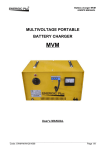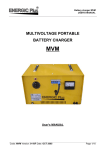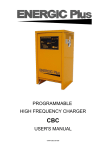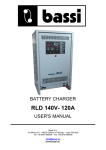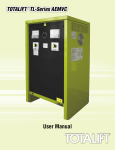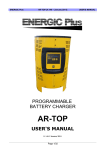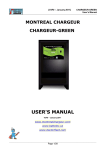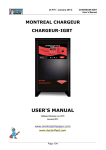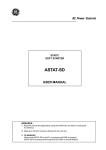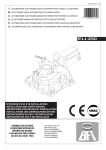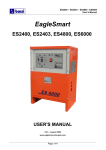Download MVC - Energic plus
Transcript
Multi-Voltage Battery charger MVC 100V-100A Code: MVC-C-380 Version: 02-AB Date: OCT2004 ___________________________________________________________________________________________________________________________________________________ INDEX · 1. INTRODUCTION..........................................................................................2 · RESPONSIBILITY DISCLAIMER................................................................................ 2 · 2. SAFETY INSTRUCTIONS AND WARNINGS.......................................... 3 · GENERAL.................................................................................................................... 3 · SHOCK PREVENTION................................................................................................ 3 · BURN AND BODILY INJURY PREVENTION.............................................................. 4 · FIRE AND EXPLOSION PREVENTION...................................................................... 4 · ARCING AND BURNING OF CONNECTOR............................................................... 4 · MEDICAL AND FIRST AID TREATMENT................................................................... 4 · EQUIPMENT WARNING LABELS.............................................................................. 4 · 3. DESCRIPTION OF THE CHARGER........................................................ 5 · TECHNICAL DATA...................................................................................................... 7 · 4. INSTALLATION OF THE CHARGER..........................................................8 · AC INPUT CONNECTION OF THE CHARGER.......................................................... 8 · HOW TO MOVE THE CHARGER............................................................................... 9 · 5. HOW TO USE THE CHARGER..............................................................10 · HOW TO CONNECT THE BATTERY AND............................................................... 11 · HOW TO MODIFY THE TIME SETTINGS DURING THE CHARGE.........................12 · HOW TO STOP THE CHARGER AND DISCONNECT THE BATTERY................... 13 · BLACKOUT OF THE AC MAIN INPUT...................................................................... 14 · THERMAL PROTECTION......................................................................................... 14 __________________________________________________________________________________________________________________________________________________ Page 1/10 Multi-Voltage Battery charger MVC 100V-100A Code: MVC-C-380 Version: 02-AB Date: OCT2004 ___________________________________________________________________________________________________________________________________________________ 1. INTRODUCTION Before starting to use your Energic Plus MVC battery charger, please take the time to read these instructions carefully. The owner’s manual is an important part of the charger. It’s recommended to keep it in good condition for the lifetime of the charger. It should be kept in a dry and clean place, always available to the users. To indicate important instructions, the following pictures are used: “Caution: ” This operation can be dangerous for the user. “Attention: ” This operation is important for the good working of the charger. On the charger, this picture is placed near devices under main supply. The charger is marked with a technical label, reporting the following data: • • • • • • • • • • • C CSA US mark; CE mark; Model; Serial number; Weight; Input voltage; Maximum input current (A); Maximum power consumption (KVA); Input frequency; Maximum voltage of the battery (output voltage); Maximum charge current (output current). RESPONSIBILITY DISCLAIMER The manufacturer of the MVC battery charger will not be responsible for damages and/or injuries caused by the charger in these situations: • • • • • • • • The charger is not installed properly by a qualified electrician; Maintenance operations are not done by a qualified electrician; The charger is not used according to the instructions included in this manual; The charger is not connected to the correct input supply (see data label on the box); The battery is damaged during the charge; The charger has been modified without the authorization of the manufacturer; Non-original spare parts are used in the charger; Wrong spare parts are used in the charger. __________________________________________________________________________________________________________________________________________________ Page 2/10 Multi-Voltage Battery charger MVC 100V-100A Code: MVC-C-380 Version: 02-AB Date: OCT2004 ___________________________________________________________________________________________________________________________________________________ 2. SAFETY INSTRUCTIONS AND WARNINGS Before starting to use your MVC battery charger, please take the time to read these instructions carefully. GENERAL Battery charging products can cause serious injury or death, or damage to other equipment or property, if the operator does not strictly observe all safety rules and take precautionary actions. Safe practices must be learned through study and training before using this equipment. Only qualified personnel should install, use, or service this equipment. SHOCK PREVENTION Bare conductors, or terminals in the output circuit, or ungrounded, electrically-live equipments can fatally shock a person. To protect against shock, have competent electrician verify that the equipment is adequately grounded and learn what terminals and parts are electrically HOT. The body’s electrical resistance is decreased when wet, permitting dangerous current to flow through the body. Do not work in damp area without being extremely careful. Stand on dry rubber mat or dry wood and use insulating gloves when dampness or sweat cannot be avoided. Keep clothing dry. INSTALLATION AND GROUNDING - A power disconnect switch must be located at the equipment. Check the data label for voltage and phase requirements. If only 3-phase power is available, connect single-phase equipment to ONLY TWO WIRES of the 3-phase line. DO NOT CONNECT the equipment grounding conductor to the third live wire of the 3-phase line as this makes the equipment frame electrically HOT, which can cause a fatal shock. If a grounding conductor is part of the power supply cable, be sure to connect it to a properly grounded switch box or building ground. If not part of the supply cable, use a separate grounding conductor. Don’t remove a ground prong from any plug. Use correct mating receptacles. Check ground for electrical continuity before using equipment. The grounding conductor must be of a size equal to or larger than the size of the line conductors. CHARGING LEADS – Inspect leads often for damage to the insulation. Replace or repair cracked or worn leads immediately. Use leads having sufficient capacity to carry the operating current without overheating. BATTERY TERMINALS – Do not touch battery terminals while equipment is operating. SERVICE AND MAINTENANCE – Shut OFF all power at the disconnect switch or line breaker BEFORE inspecting, adjusting, or servicing the equipment. Lock switch OPEN (or remove line fuses) so that the power cannot be turned ON accidentally. Disconnect power to equipment if it is to be left unattended or out of service. Disconnect battery from charger. Measure voltage on capacitors and, if there is any voltage reading, wait 5 minutes before to proceed. Keep insude parts clean and dry. Dirt and/or moisture can cause insulation failure. This failure can result in high voltage at the charger output. __________________________________________________________________________________________________________________________________________________ Page 3/10 Multi-Voltage Battery charger MVC 100V-100A Code: MVC-C-380 Version: 02-AB Date: OCT2004 ___________________________________________________________________________________________________________________________________________________ BURN AND BODILY INJURY PREVENTION The battery produces very high currents when short circuited, and will burn the skin severely if in contact with any metal conductor that is carrying this current. Do not permit rings on fingers to come in contact with battery terminals or the cell connectors on top of the battery. Battery acid is very corrosive. Alwais wear correct eye and body protection when near batteries. FIRE AND EXPLOSION PREVENTION When batteries are being recharged, they generate hydrogen gas that is explosive in certain concentrations in air (the flammability or explosive limits are 4.1% to 72% hydrogen in air). The spark-retarding vents help slow the rate of release of hydrogen, but the escaping hydrogen may form an explosive atmosphere around the battery if ventilation is poor. The ventilation system should be designed to provide an adequate amount of fresh air for the number of batteries being charged. This is essential to prevent an explosion. Always keep sparks, flames, burning cigarettes, and other sources of ignition away from the battery recharging area. Do not break "live" circuits at the terminals of batteries. Do not lay tools or anything that is metallic on top of any battery. ARCING AND BURNING OF CONNECTOR To prevent arcing and burning of the connector contacts, be sure the charger is OFF before connecting or disconnecting the battery. The ammeter should NOT indicate current flow. MEDICAL AND FIRST AID TREATMENT First aid facilities and a qualified first aid person should be available for each shift for immediate treatment of electrical shock victims. EMERGENCY FIRST AID: Call phisician and ambulance immediately and use First Aid techniques recommended by the American Red Cross. DANGER: ELECTRICAL SHOCK CAN BE FATAL. If person is unconscious and electric shock is suspected, do not touch person if he or she is in contact with charging equipment, battery, charging leads, or other live electrical parts. Disconnect power at wall switch and then use First Aid. Dry wood, wooden broom, and other insulating material can be used to move cables, if necessary, away from person. IF BREATHING IS DIFFICULT, give oxygen. IF NOT BREATHING, BEGIN ARTIFICIAL BREATHING, such as mouth-to-mouth. IF PULSE IS ABSENT, BEGIN ARTIFICIAL CIRCULATION, such as external heart massage. In case of acid in the eyes, flush very well with clean water and obtain professional medical attention immediately. EQUIPMENT WARNING LABELS Inspect all precautionary labels on the equipment. Order and replace all labels that cannot be easily read. __________________________________________________________________________________________________________________________________________________ Page 4/10 Multi-Voltage Battery charger MVC 100V-100A Code: MVC-C-380 Version: 02-AB Date: OCT2004 ___________________________________________________________________________________________________________________________________________________ 3. DESCRIPTION OF THE CHARGER Caution: THIS CHARGER CAN BE USED BY QUALIFIED PERSONNEL ONLY. Caution: THIS CHARGER HAS BEEN DESIGNED FOR PROFESSIONAL USE. ALL THE CHARGE PARAMETERS MUST BE SET BY THE USER AT EVERY CHARGE CYCLE, THEREFORE IT'S NOT SUITABLE AS A REPLACEMENT FOR TRADITIONAL CHARGERS (Energic Plus SR LINE, MTL, ...). Attention: THIS CHARGER DOES NOT HAVE PROTECTION DEVICES FOR THE BATTERY AND IT'S NOT AUTOMATIC, THEREFORE IT'S NECESSARY TO SET THE CHARGER PARAMETERS PROPERLY BEFORE EVERY CHARGE CYCLE. Attention: IF THE CHARGER IS NOT CONFIGURED PROPERLY, THE BATTERY CAB BE DAMAGED! READ THE TECHNICAL DOCUMENTATION OF THE CHARGER AND THE BATTERY BEFORE TO USE THEM AND KEEP THE TEMPERATURE OF THE BATTERY UNDER CONTROL AS LONG AS IT IS CONNECTED WITH THE CHARGER. __________________________________________________________________________________________________________________________________________________ Page 5/10 Multi-Voltage Battery charger MVC 100V-100A Code: MVC-C-380 Version: 02-AB Date: OCT2004 ___________________________________________________________________________________________________________________________________________________ The Energic Plus MVC Multivoltage battery chargers have been designed to charge Pb batteries. This equipment can convert the AC main supply in a DC output at the correct voltage, in order to charge the battery cells. This charger is controlled by a high frequency switchmode regulator, therefore it can charge batteries of any type, any voltage and ampere-hour size. The maximum DC output voltage of this charger is 100V, and the maximum DC output current is 100A. Two operating modes can be chosen: • • Current generator; IUa battery charger. In “Current generator” mode, it's possible to connect any type of battery or other loads to the charger. The output current is regulated from zero to the maximum value with the apposite potentiometer and the digital timer is used to set the totale time of charger (at constant current). This feature is useful to recover old sulphated batteries or to charge stacks of cells. In “IUa battery charger” mode, it's possible to select the voltage threshold with the apposite knob and selector. The current can be regulated with the apposite potentiometer from zero to the required value, and the time of charge can be set with the timer. When the voltage of the battery reaches the theshold value, the charger keeps this voltage constant, while the current decreases. TECHNICAL DATA External size: Weight: 500 x 440 x 900 mm 90-150 kg (see data label) These are the principal devices included in the charger, available to the user: __________________________________________________________________________________________________________________________________________________ Page 6/10 Multi-Voltage Battery charger MVC 100V-100A Code: MVC-C-380 Version: 02-AB Date: OCT2004 ___________________________________________________________________________________________________________________________________________________ • • • • • • • • LED Control panel; Amp-meter (Analog or Digital); Volt-meter (Analog or Digital); Timer (Mechanical or Digital); Knob + Selector for battery voltage setting; Potentiometer for output current setting; No.2 Cables for battery connection; No.1 Cable for main supply connection; Inside the charger there are the following devices, not available to the user: • • • • • • • • • • • AC and DC power contactors; Power transformer; Rectifier; DC link Capacitors; Cooling system (heatsink + fan); High Frequency Power Module (BASSI “MODUCHOP”); Main driver board; Auxiliary board for reverse polarity protection; Auxiliary board for voltage control; Output inductor; Ourput fuse. Please refer to the “MVC SERVICE MANUAL” (code MVC-C-SC-600) for a detailed description of the internal parts and circuits. 4. INSTALLATION OF THE CHARGER Conditions of use: • • • Operating temperature: Storage temperature: Relative humidity: 5°C to 40°C -20°C to 60°C less than 75% Caution: The charger can be installed by qualified personnel only. Attention: Check that the unit’s maximum input power is available from your power supply. Check that the unit’s operating voltage is identical to your local power supply. __________________________________________________________________________________________________________________________________________________ Page 7/10 Multi-Voltage Battery charger MVC 100V-100A Code: MVC-C-380 Version: 02-AB Date: OCT2004 ___________________________________________________________________________________________________________________________________________________ Attention: To prevent fire or shock hazard, do not expose the unit to rain or moisture. Do not use the unit in presence of flammable gas, because it can generate sparks. Caution: To avoid electrical shock, do not open the cabinet. Refer servicing to qualified personnel only. Attention: Allow adequate air circulation to prevent internal heat buildup. Do not place the unit near materials that may block the ventilation slots. Do not install the unit near heat sources such as radiators or air ducts, or in a place subject to direct sunlight, excessive dust, mechanical vibration or shock. AC INPUT CONNECTION OF THE CHARGER Check the efficiency of earth circuitry; Connect the charger to the mains using an adequate plug, with switch and fuses; Use an adequate wire and plug to connect the charger to the battery. Refer to the data label on the charger for maximum input power (KVA) and current (AMPS). • The charger doesn't need AC input voltage adjustments, however it's recommended to check with an adequate AC-voltmeter that the input voltage is within the specified range. • • • HOW TO MOVE THE CHARGER Caution: Before to move the charger, disconnect it from the main supply and from the battery. To protect the charger while moving, use the original package or equivalent. Caution: Don't use hooks to lift the charger. Caution: Don't rotate the charger while moving, it must be kept in vertical position. Caution: If the charger is moved using a forklift or a transpallet, the cables should be fixed to the top of the charger with adhesive tape. __________________________________________________________________________________________________________________________________________________ Page 8/10 Multi-Voltage Battery charger MVC 100V-100A Code: MVC-C-380 Version: 02-AB Date: OCT2004 ___________________________________________________________________________________________________________________________________________________ 5. HOW TO USE THE CHARGER HOW TO CONNECT THE BATTERY AND START THE CHARGE Caution: Before to use the charger, take the time to read all this manual carefully! Caution: For a safe operation, follow these instructions carefully, in the exact sequence! A) THE CHARGER MUST BE SWITCHED OFF BEFORE TO CONNECT THE BATTERY. Check that both the Volt-Meter and the Amp-meter indicate ZERO. Check that the Current Potentiometer is in position ZERO. B) CONNECT THE BATTERY. The charger is protected against the polarity reversal, however, check the battery polarity when connecting the battery leads. When the battery is connected, read its voltage on the Volt-Meter. C) SWITCH ON THE CHARGER BY PROGRAMMING THE TIME OF CHARGE ON THE TIMER. The control circuits and the cooling system of the charger are powered. The YELLOW status LED “BOOTSTRAP” turns on for 1 to 10 seconds, then the GREEN status LED “In service” turns on. D) WHILE THE CURRENT POTENTIOMETER IS STILL IN POSITION ZERO, SELECT THE REQUIRED BATTERY VOLTAGE WITH THE APPOSITE KNOB. The current remains ZERO. Please look and understand how the voltage selector works: there are two sectors (2,4 and 2,5 V/cell) which can be selected with the small switch, and the knob can move on six nominal voltages (24-36-40-48-72-80 V). The table below the selector indicates the actual regulated voltages. H) ADJUST THE OUTPUT CURRENT TO THE DESIRED VALUE, USING THE CURRENT POTENTIOMETER. While you increase the current, keep under control the battery connectors to avoid the risk of sparks and/or fire. During the charge, the current and the voltage can be modified directly with the apposite knob and potentiometer. __________________________________________________________________________________________________________________________________________________ Page 9/10 Multi-Voltage Battery charger MVC 100V-100A Code: MVC-C-380 Version: 02-AB Date: OCT2004 ___________________________________________________________________________________________________________________________________________________ HOW TO STOP THE CHARGER AND DISCONNECT THE BATTERY Caution: Before to use the charger, take the time to read all this manual carefully! Caution: For a safe operation, follow these instructions carefully, in the exact sequence! A) SET THE CURRENT POTENTIOMETER TO ZERO. Check on the AMP-METER that the current is now ZERO. B) SET THE VOLTAGE SELECTION KNOB TO 24V. C) MOVE THE TIMER TO POSITION ZERO. D) DISCONNECT THE BATTERY. THERMAL PROTECTION If the cooling system fails and/or the power electronic components of the charger reach a temperature higher than a maximum value, the current is automatically set to ZERO until the temperature decreases below the limit and the red status LED “THERMAL PROTECTION” is activated, - END OF MANUAL - Bassi Bruno elettromeccanica & C. 2004 __________________________________________________________________________________________________________________________________________________ Page 10/10










